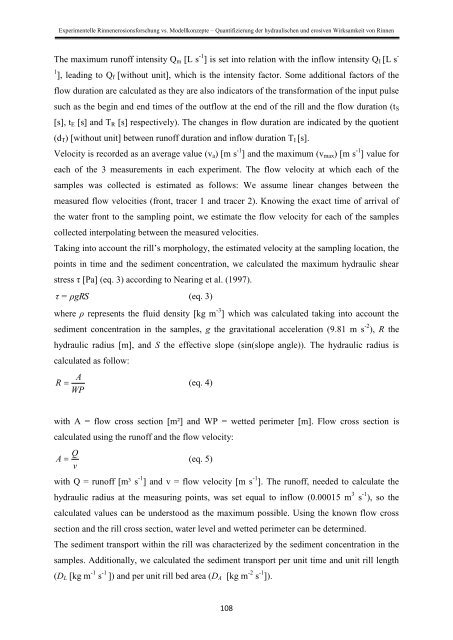Stefan Wirtz Vom Fachbereich VI (Geographie/Geowissenschaften ...
Stefan Wirtz Vom Fachbereich VI (Geographie/Geowissenschaften ...
Stefan Wirtz Vom Fachbereich VI (Geographie/Geowissenschaften ...
You also want an ePaper? Increase the reach of your titles
YUMPU automatically turns print PDFs into web optimized ePapers that Google loves.
Experimentelle Rinnenerosionsforschung vs. Modellkonzepte – Quantifizierung der hydraulischen und erosiven Wirksamkeit von Rinnen<br />
The maximum runoff intensity Q m [L s -1 ] is set into relation with the inflow intensity Q I [L s -<br />
1 ], leading to Q f [without unit], which is the intensity factor. Some additional factors of the<br />
flow duration are calculated as they are also indicators of the transformation of the input pulse<br />
such as the begin and end times of the outflow at the end of the rill and the flow duration (t S<br />
[s], t E [s] and T R [s] respectively). The changes in flow duration are indicated by the quotient<br />
(d T ) [without unit] between runoff duration and inflow duration T I [s].<br />
Velocity is recorded as an average value (v a ) [m s -1 ] and the maximum (v max ) [m s -1 ] value for<br />
each of the 3 measurements in each experiment. The flow velocity at which each of the<br />
samples was collected is estimated as follows: We assume linear changes between the<br />
measured flow velocities (front, tracer 1 and tracer 2). Knowing the exact time of arrival of<br />
the water front to the sampling point, we estimate the flow velocity for each of the samples<br />
collected interpolating between the measured velocities.<br />
Taking into account the rill’s morphology, the estimated velocity at the sampling location, the<br />
points in time and the sediment concentration, we calculated the maximum hydraulic shear<br />
stress τ [Pa] (eq. 3) according to Nearing et al. (1997).<br />
τ = ρgRS<br />
(eq. 3)<br />
where ρ represents the fluid density [kg m -3 ] which was calculated taking into account the<br />
sediment concentration in the samples, g the gravitational acceleration (9.81 m s -2 ), R the<br />
hydraulic radius [m], and S the effective slope (sin(slope angle)). The hydraulic radius is<br />
calculated as follow:<br />
A<br />
R (eq. 4)<br />
WP<br />
with A = flow cross section [m²] and WP = wetted perimeter [m]. Flow cross section is<br />
calculated using the runoff and the flow velocity:<br />
Q<br />
A (eq. 5)<br />
v<br />
with Q = runoff [m³ s -1 ] and v = flow velocity [m s -1 ]. The runoff, needed to calculate the<br />
hydraulic radius at the measuring points, was set equal to inflow (0.00015 m 3 s -1 ), so the<br />
calculated values can be understood as the maximum possible. Using the known flow cross<br />
section and the rill cross section, water level and wetted perimeter can be determined.<br />
The sediment transport within the rill was characterized by the sediment concentration in the<br />
samples. Additionally, we calculated the sediment transport per unit time and unit rill length<br />
(D L [kg m -1 s -1 ]) and per unit rill bed area (D A [kg m -2 s -1 ]).<br />
108
















